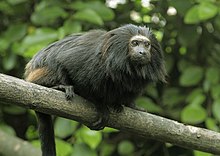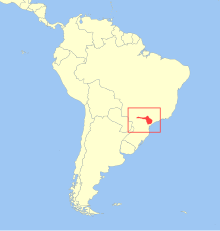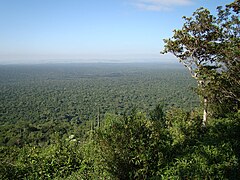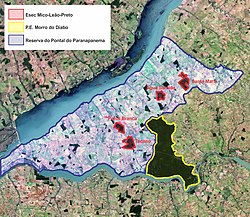Black lion tamarin
| Black lion tamarin[1][2] | |
|---|---|

| |
| Black lion tamarin at Bristol Zoo | |
| Scientific classification | |
| Domain: | Eukaryota |
| Kingdom: | Animalia |
| Phylum: | Chordata |
| Class: | Mammalia |
| Order: | Primates |
| Suborder: | Haplorhini |
| Infraorder: | Simiiformes |
| Family: | Callitrichidae |
| Genus: | Leontopithecus |
| Species: | L. chrysopygus
|
| Binomial name | |
| Leontopithecus chrysopygus (Mikan, 1823)
| |

| |
| Synonyms | |
|
ater Lesson, 1840 | |
The black lion tamarin (Leontopithecus chrysopygus), also known as the golden-rumped lion tamarin, is a
A 2020 assessment by the
On average, the black lion tamarin weighs 300–700 grams (11–25 oz).[8]
Taxonomy
The classification of the black lion tamarin was debated, as one group of taxonomists classified the lion tamarins by their geography, while other taxonomists placed them all into one species and then divided them into subspecies. More recently, taxonomists have agreed to base classification predominantly on their geography, though sometimes characteristics such as long calls are used to classify different species, similar to the use of
Behaviour and ecology
Diet

The diet of the black lion tamarin is seasonal and varies with the habitats it moves through.[6] When the tamarin is in the dryland forest, it usually eats a variety of fruits, whereas in a swampy environment it predominantly feeds on the gum of various trees.[6] In addition to seasonal variation, the black lion tamarin exhibits daily and monthly cycles of food preferences.[9]
Independent of the environment it occupies, a tamarin spends long periods each day searching for different types of
The black lion tamarin eats the gum and fruit of trees, climbing up to ten meters to reach them and as these are easily found, the tamarin spends 12.8% of its day obtaining them, rather than the 41.2% of the day spent foraging for insects in the high trees.[6]
Reproduction
Black lion tamarins mate and have offspring during the spring, summer, and fall months (August to March in Brazil).
Most
Most infants deaths occur within the first two weeks of birth, with newborns of first-time mothers having the lowest survival rates. The number of tamarins that survive to adulthood in the wild is 10% higher than those in captivity.[10]
Food sharing
During the first few months after birth, the infant is unable to obtain food on its own. For this reason, the infant rides on the parent's back and receives food from the parents. It drinks milk in the 4 to 5 weeks after birth; after that, the parents and other group-members share food with the infant. Sharing involves both offers from the parents and begging by the infant. Usually, until the age of approximately 15 weeks, the infant will receive the majority of its food (especially insects) from others.[11] The number of offers from group-members peaks at week 7; after week 15, sharing slowly declines, stopping by week 26.[11]
Communication

Within Leontopithecus, the black lion tamarin is the largest in size and has the lowest-pitched calls, using longer notes than other species.[5] The black lion tamarin use calls to defend territory, maintain cohesion within the group, attract a mate, and contact individuals who might be lost. Most calls can be recorded in the morning, and can be attributed to the reunion of mated pairs. Mated pairs are mostly monogamous but polyandry has been observed in some populations.[8]
Conservation

The black lion tamarin is rated
There have been several attempts to bring black lion tamarins into captivity and to salvage what little habitat they have left within the Morro do Diabo State Park, as well as to increase breeding rates. Their population decline in the wild, however, could cause the black lion tamarins to become entirely endemic to the Morro do Diabo.
References
- OCLC 62265494.
- ISBN 978-0-387-78704-6.
- ^ . Retrieved 19 November 2021.
- ^ "Appendices | CITES". cites.org. Retrieved 2022-01-14.
- ^ S2CID 83673079.
- ^ S2CID 41247033.
- ^ Mico-leão-preto ressurge na Estação Ecológica Caetetus (in Portuguese), Fundação Florestal, 8 September 2016, retrieved 2017-02-21
- ^ a b Gray, D. (2003). "Black lion tamarin (Leontopithecus chrysophygus)". Animal Diversity Web (ADW). Animal Diversity Web. Retrieved 2021-03-30.
- .
- ^ S2CID 84924113.
- ^ S2CID 8927814.
- ^ .

